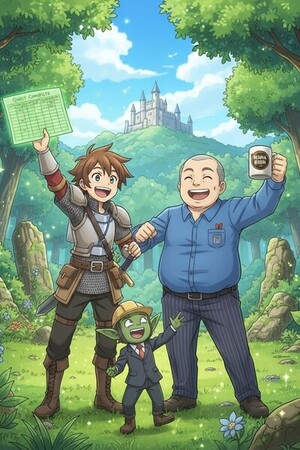Chapter 21:
Hiroshi's Tactics
Earthly Solutions
The attack, when it finally came, was both more and less dramatic than I'd expected.
More dramatic because watching actual combat unfold outside our office windows was genuinely terrifying, regardless of how many fantasy games I'd played or light novels I'd read. The sound of steel on steel, the impact of magical attacks against defensive barriers, and the general chaos of people trying to hurt each other was nothing like the sanitized version I'd imagined.
Less dramatic because the actual tactics involved were... well, let's just say that real-world combat was apparently much less sophisticated than the strategic encounters I'd studied in countless RPG guides.
"They're using a standard breach-and-intimidate formation," I observed to Finn as we watched Malachar's hired muscle approach our defensive perimeter. "Heavy fighters in front to absorb damage, ranged attackers in back for support, and what appears to be a mage for area denial."
"You can analyze combat formations?" Finn asked, sounding impressed despite the circumstances.
"I've been studying fantasy combat scenarios for years," I replied, watching the attackers organize themselves with growing confidence. "And these guys are making some pretty obvious strategic errors."
The lead attacker was a [Human Warrior, Level 16] in heavy plate armor who was clearly counting on intimidation factor rather than tactical sophistication. Behind him were two [Human Fighters, Level 14-15] with similar equipment and what appeared to be similar strategic thinking. The ranged support consisted of an [Elf Archer, Level 13] and a [Human Mage, Level 12] who were positioning themselves for what looked like standard suppression tactics.
"What kind of errors?" Selena asked, checking her own equipment while observing the enemy formation.
"They're assuming this is going to be a straightforward intimidation scenario rather than actual combat," I explained. "Look at their positioning—they're optimized for looking threatening, not for dealing with organized resistance."
I pointed toward their formation. "The heavy fighters are clustered together, which makes them vulnerable to area-effect attacks. The archer has positioned himself where his sightlines are partially blocked by the warriors. And the mage is standing in the open instead of using cover, which suggests he's planning to rely on intimidation spells rather than combat magic."
"You can tell all that just from watching them approach?" Mr. Tanaka asked, clutching his briefcase but paying attention to my analysis.
"Basic tactical assessment," I confirmed. "Plus, I recognize the formation—it's a classic 'scare the civilians' setup from dozens of scenarios I've analyzed. Effective against untrained targets, but vulnerable to anyone who understands combat positioning."
Finn was making rapid notes. "What do you recommend for our defensive strategy?"
I studied our available resources: a dozen client-volunteers with varying combat capabilities, defensive positions around our office building, and what appeared to be genuinely superior tactical knowledge thanks to years of analyzing fantasy combat scenarios.
"We use their overconfidence against them," I said. "They're expecting us to either surrender immediately or panic and fight chaotically. Instead, we demonstrate organized resistance that exploits their positioning weaknesses."
"Specifically?"
"Megan," I called to our Arch-wizard client, who was preparing what appeared to be high-level offensive spells. "What's your most effective area-denial magic?"
"Ice Barrier is probably the most tactically useful," she replied. "Creates temporary cover and limits enemy movement options."
"Perfect. Can you position barriers to split their formation and force the heavy fighters to approach along predictable routes?"
"Absolutely."
I turned to the [Dwarf Fighter, Level 14] who had become something of an informal tactical leader among our defenders. "Can your party handle the heavy fighters if they're separated and channeled into positions where they can't support each other effectively?"
"If they're coming at us one or two at a time instead of all together? No problem."
"And the archer?"
"Leave him to me," said the [Human Crusader, Level 21] with the kind of confident certainty that suggested this wouldn't be his first ranged combat engagement.
The beauty of the plan was its simplicity. Instead of trying to match their raw combat power, we were using superior tactical coordination to force them into disadvantageous engagements where their numerical and level advantages became irrelevant.
"What about the mage?" Selena asked.
I considered this for a moment, then grinned. "The mage is actually our biggest advantage."
"How so?"
"Because he's positioned himself based on the assumption that he'll be casting intimidation magic against frightened civilians. He's not prepared for actual combat casting under pressure." I pointed toward his position. "Look at where he's standing—optimal for dramatic effect, terrible for tactical flexibility. If we can force him to move or take defensive action, he'll probably panic and either retreat or make positioning errors that neutralize his effectiveness."
"And how do we force him to move?"
"We demonstrate that we're not intimidated by his presence and that we understand his vulnerabilities better than he understands ours."
The actual implementation of our tactical plan was remarkably effective, largely because our opponents had prepared for intimidation rather than combat.
Megan's Ice Barriers split their formation exactly as predicted, forcing the heavy fighters to approach through narrow corridors where they couldn't coordinate their attacks or provide mutual support. Our client-defenders engaged them individually rather than being overwhelmed by coordinated assault.
The archer found himself targeted by a Crusader who apparently had extensive experience dealing with ranged attackers and knew exactly how to close distance while minimizing exposure to arrow fire.
But the real validation of my tactical analysis came when the mage, faced with organized resistance instead of cowering civilians, attempted to cast what appeared to be a fear-effect spell and discovered that his positioning left him completely exposed to counterattack from multiple directions simultaneously.
"He's panicking," I observed as the mage abandoned his original position and scrambled for cover behind what had been the heavy fighters' formation. "Classic mistake—when your initial tactical assumption proves wrong, novice spellcasters tend to prioritize personal safety over mission effectiveness."
"Which means?"
"Which means he's no longer providing magical support for his team's assault, and they're now fighting at a significant disadvantage."
The entire engagement lasted maybe ten minutes, ending not with dramatic victory or crushing defeat, but with Malachar's hired muscle recognizing that they were fighting a losing battle against better-organized opponents and choosing to withdraw rather than risk serious injury for what was probably not very lucrative employment.
"That's it?" Mr. Tanaka asked as we watched the attackers retreat toward the guild district. "They're just leaving?"
"Professional mercenaries rarely continue engagements once it becomes clear that the cost-benefit analysis doesn't favor success," Finn explained. "They were hired for intimidation, not actual combat against organized resistance."
I watched the retreating figures and felt a surge of satisfaction that had nothing to do with winning a fight and everything to do with successfully applying theoretical knowledge to practical challenges.
"Yamamoto," Selena said, "that was impressive tactical analysis. Where did you learn combat strategy?"
"Years of studying fantasy combat scenarios and tactical guides," I admitted. "I never thought I'd actually use any of it, but apparently understanding the logic behind various combat formations translates to real-world application."
"So your gaming knowledge wasn't just helpful for understanding this world's economic systems," Mr. Tanaka observed. "It was also useful for defending our business against physical threats."
"Apparently so."
As our client-volunteers began organizing post-combat assessment and damage evaluation, I realized that our interdimensional business adventure had just demonstrated something remarkable: the combination of systematic analysis, tactical knowledge, and client loyalty could successfully defend against corruption and intimidation.
But more importantly, it had proven that the skills we'd brought from our world—Mr. Tanaka's bureaucratic expertise and my genre knowledge—weren't just useful for building a business. They were genuinely valuable for protecting the community we'd accidentally created around that business.
"Think Malachar will try again?" I asked.
"Not with direct intimidation," Mr. Tanaka replied, reviewing damage reports with systematic precision. "This failure will force him to rely on his remaining bureaucratic advantages, which plays to our strengths rather than his."
I looked around our successfully defended office, surrounded by clients who had volunteered to fight for our business, and realized that we'd accomplished something I'd never expected: we'd created something worth defending.
And apparently, we were pretty good at defending it.




Please sign in to leave a comment.